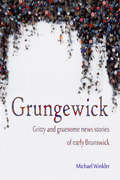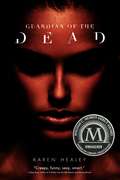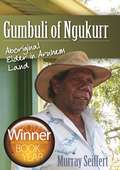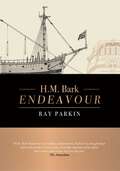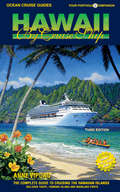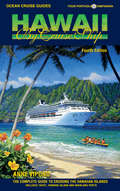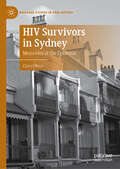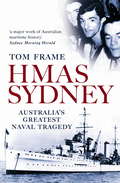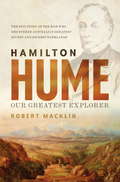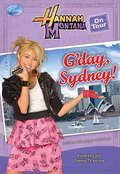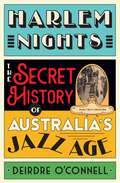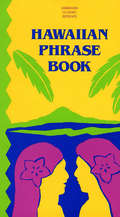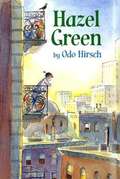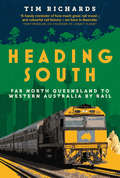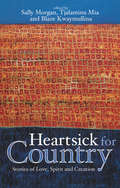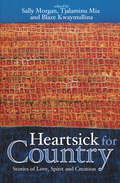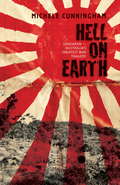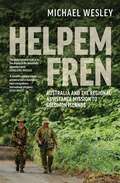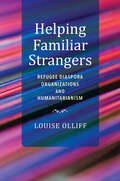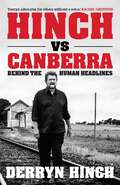- Table View
- List View
Grungewick
by Michael WinklerMurder. Mayhem. Misdeeds. In the nineteenth century, Brunswick was a satellite suburb of Melbourne. While the big city boomed, Brunswick was a place of "bricks and pottery, mud and poverty" with the unruliness of a frontier town. This collection of contemporary newspaper stories provides a vivid picture of the seamy side of life in 1800s Brunswick. It includes famous outrages such as the trial and execution of 'baby farmer' Frances Knorr; Mary Ryckman attacking her neighbour with dynamite; and the outbreak of Irish sectarian violence in Sydney Road. It also captures lesser-known incidents that, together, portray a much harder time: street larrikins, pub brawls, industrial deaths, poisoning both accidental and deliberate. Grungewick provides an unusual window into Australian life in the 1800s and shows that, even when times are toughest, the dignity and resilience of everyday people can shine through.
Guardian of the Dead
by Karen HealeyEighteen-year-old New Zealand boarding school student Ellie Spencer must use her rusty tae kwon do skills and new-found magic to try to stop a fairy-like race of creatures from Maori myth and legend that is plotting to kill millions of humans in order to regain their lost immortality.
Gumbuli of Ngukurr: Aboriginal elder in Arnhem Land
by Murray SeiffertTwo stories overlap and interweave in this biography of Gumbuli of Ngukurr. One is of a remarkable Aboriginal elder, Michael Gumbuli Wurramara, whose early life was spent on remote islands in the Gulf of Carpentaria. As a teenager, he moved to the historic Roper River Mission, which became known as Ngukurr when the government took over its control. Gumbuli was one of the community leaders who fought hard to achieve local decision-making at this time of dramatic change. Later he became the first Aboriginal Anglican priest in the Northern Territory and for over 30 years, leader of the Arnhem Land Anglicans and 'architect' of the Kriol Bible Translation Project. He faced many of the challenging issues arising from traditional Aboriginal ways meeting Western culture and the Christian faith. The second story describes the Ngukurr community in the second half of the twentieth century, as it seeks to achieve a mix of ancient and modern cultures. Along the way, issues arise such as health, employment, economics, welfare, Stolen Generation, polygamy, alcohol and Aboriginal spirituality. The plea of 'Why don't you ask us?' seems to fall on deaf ears in each generation. Extremely readable and thought-provoking, this work is based on extensive interviews, observation and archival research. It challenges many assumptions about the relationships between government, missions and Aborigines. A collection of photographs, many of historical importance, accompanies the text.
H.M. Bark Endeavour: Updated Edition
by Ray ParkinHere, in one accessible volume, is Ray Parkin's highly acclaimed and multi-award winning study of Captain James Cook's Endeavour. This incomparable book is a unique account of a great journey-Endeavour's voyage up the east coast of Australia in 1770-and a remarkable re-creation of the experience of being on board ship. Parkin draws on meticulous research to reveal what the Endeavour looked like, how it sailed, how it smelled, what daily life would have been like for those on board. How many strands of yarn were in the ship's cable? (954.) Did the ship have a lightning conductor? (Yes.) What was the diameter of her main mast? (21 inches.) These details are illustrated by plans and figures depicting the ship's architecture and construction, its deck plan, rigging, sails, armament, boats, cables, anchors and accommodation, all beautifully drawn by Parkin. A composite log of Endeavour's voyage-extracts from journals kept by those on board-is supplemented by an interpretive commentary and explanatory charts. H.M. Bark Endeavour is an absorbing book: discursive, erudite, at times poetic, full of wisdom, insight and information.
HAWAII BY CRUISE SHIP – 3rd Edition: The Complete Guide to Cruising the Hawaiian Islands. Includes Tahiti, Fanning Island and Mainland Ports.
by Anne VipondThis new edition covers all the islands and attractions that make Hawaii such a great cruising destination. Extensive shore excursion detail and cruise-and-stay options are included as are insider tips on selecting and preparing for your Hawaii cruise. Detailed maps show exactly where the ships dock and locations of of leading hotels on Oahu and Maui. Includes tips on shipboard life, activities and cabin selection. The author also gives readers insight into extra expenses and handling gratuities for stewards and waiters. Hawaii By Cruise Ship gives readers a history of the rich Hawaiian culture and how the islands changed with the arrival of Europeans. A section of the book also outlines the wildlife that can be seen in Hawaii and includes a map showing the best whalewatching locations. Over 400 color photographs and dozens of color maps detailing the islands, ports and attractions are complement the text. This new edition also includes coverage of the South Pacific and French Polynesia as well as the mainland ports from San Diego and Los Angeles to Vancouver.
HAWAII BY CRUISE SHIP – 4th Edition: The Complete Guide to Cruising the Hawaiian Islands Includes Tahiti, Fanning Island and Mainland Ports
by Anne VipondThis new edition covers all the islands and attractions that make Hawaii such an attractive cruise destination. Extensive shore excursion detail and cruise-and-stay options are included with tips on selecting your cruise and cabin as well as preparing for your Hawaii cruise. The author also gives readers insight into extra expenses and handling gratuities for stewards and waiters with background on shipboard life and activities. Detailed maps show exactly where the ships dock and locations of leading hotels on Oahu and Maui. Hawaii By Cruise Ship includes history of the rich Hawaiian culture and how the islands changed with the arrival of Europeans. A section of the book also outlines the wildlife that can be seen in Hawaii includings maps with best whalewatching locations. Over 400 color photographs and dozens of color maps detailing the islands, ports and attractions complement the text. Includes islands of the South Pacific, French Polynesia and mainland ports from San Diego and Los Angeles to Vancouver.
HIV Survivors in Sydney: Memories of the Epidemic (Palgrave Studies in Oral History)
by Cheryl WareInner-city Sydney was the epicenter of gay life in the Southern hemisphere in the 1970s and early 1980s. Gay men moved from across Australasia to find liberation in the city’s vibrant community networks; and when HIV and AIDS devastated those networks, they grieved, suffered, and survived in ways that have often been left out of the historical record. This book excavates the intimate lives and memories of HIV-positive gay men in Sydney, focusing on the critical years between 1982 and 1996, when HIV went from being a terrifying unidentified disease to a chronic condition that could be managed with antiretroviral medication. Using oral histories and archival research, Cheryl Ware offers a sensitive, moving exploration of how HIV-positive gay men navigated issues around disclosure, health, sex, grief, death, and survival. HIV Survivors in Sydney reveals how gay men dealt with the virus both within and outside of support networks, and how they remember these experiences nearly three decades later.
HMAS Sydney
by Tom FrameThe complete and authoritative account of the sinking of the HMAS Sydney, and the recent finding of her wreck.On 19 November 1941, the pride of the Australian Navy, the light cruiser Sydney, fought a close-quarters battle with the German armed raider HSK Kormoran off Carnarvon on the West Australian coast. Both ships sank ? and not one of the 645 men on board the Sydney survived. Was Sydney?s captain guilty of negligence by allowing his ship to manoeuvre within range of Kormoran?s guns? Did the Germans feign surrender before firing a torpedo at the Sydney as she prepared to despatch a boarding party? This updated edition covers the recent discovery of the wreck ? with the light this sheds on the events of that day 67 years ago, and the closure it has brought to so many grieving families. `Tom Frame has produced the most comprehensive and compelling account of the loss of HMAS Sydney to date. His judgements are fair and his conclusions reasoned. If you only read one book on this tragic event in Australian naval history, and want all the facts and theories presented in a balanced way, Tom Frame?s book is for you? - Vice Admiral Russ Shalders AO CSC RANR Chief of Navy, 2005-08.
Hamilton Hume: Our Greatest Explorer
by Robert MacklinThe untold story of Hamilton Hume - the Australian-born explorer who truly opened up the nation.While English-born soldiers, sailors and surveyors have claimed pride of place among the explorers of the young New South Wales colony, the real pathfinder was a genuine native-born Australian. Hamilton Hume, a man with a profound understanding of the Aboriginal people and an almost mystical relationship with the Australian bush, led settlers from the cramped surrounds of Sydney Town to the vast fertile country that would provide the wealth to found and sustain a new nation.Robert Macklin, author of the critically acclaimed Dark Paradise, tells the heroic tale of this young Australian man who outdid his English 'betters' by crossing the Blue Mountains, finding a land route from Sydney to Port Phillip and opening up western New South Wales. His contribution to the development of the colony was immense but downplayed in deference to explorers of British origin. Hamilton Hume uncovers this brave man's achievements and paints an intriguing and at times shocking portrait of colonial life, by the author of the bestselling SAS Sniper.
Handbook of Civil Society and Social Movements in Small States (Europa International Perspectives)
by Lino Briguglio Claire Slatter Michael Briguglio Sheila BunwareeThis volume is unique because of its focus on small states. There are many studies on civil society and social movements, but none that specifically deal with this category of countries. As is well known, small states have particular characteristics, including a limited ability to reap the benefits of economies of scale, a high degree of exposure to forces outside their control, and the proximity of politicians to the voters, often leading to clientelistic relationships and patronage networks. The small island developing states have the additional problem of high environmental vulnerability, with some also dealing with disproportionate ecological footprints. These factors have a bearing on the organization and performance of civil society organizations and social movements, as explained in several chapters of this book. The volume is organized in three parts, dealing with aspects of civil society and social moments in small states in the political, social and environmental spheres, respectively. Various definitions of civil society are proposed in the chapters, but most authors associate the term with organized groups, operating in the interest of citizens, independently of government and commercial business, including various forms of non-governmental organizations (NGOs). Civil society also encompasses social movements, which are considered to be loosely organized collective campaigns in pursuit of social goals. These two terms are sometimes used interchangeably; however, some authors argue that social movements tend to engage in ‘contentious politics’ including protests, while NGOs engage through more organized and institutional routes.
Handbook of Civil Society and Social Movements in Small States (Europa International Perspectives)
by Lino BriguglioThis volume is unique because of its focus on small states. There are many studies on civil society and social movements, but none that specifically deal with this category of countries. As is well known, small states have particular characteristics, including a limited ability to reap the benefits of economies of scale, a high degree of exposure to forces outside their control, and the proximity of politicians to the voters, often leading to clientelistic relationships and patronage networks. The small island developing states have the additional problem of high environmental vulnerability, with some also dealing with disproportionate ecological footprints. These factors have a bearing on the organization and performance of civil society organizations and social movements, as explained in several chapters of this book. The volume is organized in three parts, dealing with aspects of civil society and social moments in small states in the political, social and environmental spheres, respectively. Various definitions of civil society are proposed in the chapters, but most authors associate the term with organized groups, operating in the interest of citizens, independently of government and commercial business, including various forms of non-governmental organizations (NGOs). Civil society also encompasses social movements, which are considered to be loosely organized collective campaigns in pursuit of social goals. These two terms are sometimes used interchangeably; however, some authors argue that social movements tend to engage in ‘contentious politics’ including protests, while NGOs engage through more organized and institutional routes.
Hannah Montana On Tour: G'day, Sydney!
by DISNEY BOOK GROUPHannah Montana is off to the second city on her tour: Sydney. But when Jackson gets hit in the head with a boomerang, it starts an adventure faster than you can say, "Put some shrimp on the barbie."
Harlem Nights: The Secret History of Australia's Jazz Age
by Deirdre O'ConnellThe 1920s were a time of wonder and flux, when Australians sensed a world growing smaller, turning faster-and, for some, skittering off balance. American movies, music and dance brought together what racial lines kept apart. A spirit of youthful rebellion collided with the promise of racial perfectibility, stirring deep anxieties in white nationalists and moral reformers. African-American jazz represented the type of modernism that cosmopolitan Australians craved-and the champions of White Australia feared. Enter Sonny Clay's Colored Idea. Snuck in under the wire by an astute promoter, the Harlem-style revue broke from the usual blackface minstrel fare, delivering sophisticated, liberating rhythms. The story of their Australian tour is a tale of conspiracy-a secret plan to kick out and keep out 'undesirable' expressions of modernism, music and race. From the wild jazz clubs of Prohibition-era LA to Indigenous women discovering a new world of black resistance, this anatomy of a scandal-fuelled frame-up brings into focus a vibrant cast of characters from Australia's Jazz Age.
Hawaiian Phrase Book
by Charles E. Tuttle Company, Inc.Originally, the primary object of this manual was to teach natives to converse in English. At the same time, the work is designed to assist strangers, speaking English, to acquire the correct colloquial speech of the Hawaiians.
Hazel Green
by Odo HirschEach year, on Frogg Day, a parade fills the streets and children are not allowed to take part, but it hasn't always been that way and it certainly doesn't seem fair to Hazel Green. So she decides to rally the children of the Moody Building to build a float for the parade. But things go awry when she is accused of stealing a recipe from her favorite baker and giving it to his rival. At the same time, the children ban her from participating in the parade because she tried to convince them that their float would topple. But with the help of her friend Yakov, a.k.a. "The Yak," Hazel proves her innocence and leads the children to glory on Frogg Day. From Odo Hirsch, an internationally best-selling author, and in the spirit of Harriet the Spy and Anastasia Krupnik, comes this spunky, unforgettable, irresistible character: Hazel Green. "Sometimes you really are terrible, Hazel." Good, thought Hazel Green. Everyone should be terrible sometimes.
Heading South: Far North Queensland to Western Australia by Rail
by Tim RichardsFreelance travel writer and Lonely Planet guidebook contributor Tim Richards decides to shake up his life by taking an epic rail journey across Australia. Jumping aboard iconic trains like the Indian Pacific, Overland and Spirit of Queensland, he covers over 7,000 kilometres, from the tropics to the desert and from big cities to ghost towns. Tim's journey is one of classic travel highs and lows: floods, cancellations, extraordinary landscapes and forays into personal and public histories – as well as the steady joy of random strangers encountered along the way.
Heartsick for Country: Stories of Love, Spirit and Creation
by Sally Morgan Blaze Kwaymullina Tjalaminu MiaThe stories in this anthology speak of the love between Aboriginal peoples and their countries. They are personal accounts that share knowledge, insight and emotion, each speaking of a deep connection to country and of feeling heartsick because of the harm that is being inflicted on country even today, through the logging of old growth forests, converting millions of acres of land to salt fields, destruction of ancient rock art and significant Aboriginal sacred sites, and a record of species extinction that is the worst in the world.
Heartsick for Country: Stories of Love, Spirit and Creation
by Sally Morgan; Tjalaminu Mia; Blaze KwaymullinaThe stories in this anthology speak of the love between Aboriginal peoples and their countries. They are personal accounts that share knowledge, insight and emotion, each speaking of a deep connection to country and of feeling heartsick because of the harm that is being inflicted on country even today, through the logging of old growth forests, converting millions of acres of land to salt fields, destruction of ancient rock art and significant Aboriginal sacred sites, and a record of species extinction that is the worst in the world.
Hell on Earth: Sandakan - Australia's Greatest War Tragedy
by Michele CunninghamThe heart-rending story of the Australians brutally imprisoned in Sandakan, the Japanese POW camp in North Borneo, whose very name came to symbolise cruelty and ill-treatment.In mid-1942, after the fall of Singapore, almost three thousand Allied prisoners of war were taken by the Japanese from Changi to Sandakan. Of those, 2500 lost their lives.Men died at Sandakan and on the infamous death marches: they died from sickness and starvation, torture and appalling violence, or were killed by the guards as they were forced to keep moving along a seemingly never-ending track. Only six Australians survived the death marches, out of the thousand who left ...Michele Cunningham's father was one of those who survived Sandakan, and then Kuching. Through the mateship and common bond of the survivors, she has had access to their stories, and here she gives an account of these courageous men ? those who refused to break no matter how badly they were treated; and those brave men who didn't make it. And it is the story of the depths to which the Japanese sank.Hell on Earth is a remarkable story of bravery, brutality, mateship and survival.
Helpem Fren: Australia and the Regional Assistance Mission to Solomon Islands 2003–2017
by Michael WesleyIn 2003 Australia conceived, financed and led a Pacific-wide intervention into Solomon Islands to prevent the collapse of that state. The Regional Assistance Mission to Solomon Islands (RAMSI) was to remain there for fourteen years, costing over $2 billion and involving thousands of soldiers, police and public servants from Australia and across the Pacific. It was remarkably successful in an age of disastrous interventions. And yet, by the time it was withdrawn, RAMSI had largely vanished from the Australian public's mind. Helpem Fren is the first comprehensive history of Australia and the RAMSI intervention. Drawing on still-classified official documents and over thirty interviews, it records the preconditions, motivations and dynamics of RAMSI between 2003 and 2017. Providing an intimate look at the challenges of interventions and development assistance generally, Helpem Fren is also a portrait of the personalities involved and the complex interactions between two systems that couldn't be more different in culture, wealth, size and capacity. As Australia confronts the most challenging environment in the Pacific for seventy years, Helpem Fren offers readers a deeper understanding of the recent history of Australia's involvement with Solomon Islands and the Pacific.
Helping Familiar Strangers: Refugee Diaspora Organizations and Humanitarianism (Worlds in Crisis: Refugees, Asylum, and Forced Migration)
by Louise OlliffWho helps in situations of forced displacement? How and why do they get involved?In Helping Familiar Strangers, Louise Olliff focuses on one type of humanitarian group, refugee diaspora organizations (RDOs), to explore the complicated impulses, practices, and relationships between these activists and the "familiar strangers" they try to help. By documenting findings from ethnographic research and interviews with resettled and displaced persons, RDO representatives, and humanitarian professionals in Australia, Switzerland, Thailand, and Indonesia, Olliff reveals that former refugees are actively involved in helping people in situations of forced displacement and that individuals with lived experience of forced displacement have valuable knowledge, skills, and networks that can be drawn on in times of humanitarian crisis.We live in a world where humanitarians have varying motivations, capacities, and ways of helping those in need, and Helping Familiar Strangers confirms that RDOs and similar groups are an important part of the tapestry of care that people turn to when seeking protection far from home.
Henry and Banjo: The Tumultuous Lives And Times Of Henry Lawson And Banjo Paterson, The Men Who Wrote Australia's History
by James KnightThe fascinating lives and turbulent times of Henry Lawson and Andrew 'Banjo' Paterson - the two men who wrote Australia's story.Today most of us know that Henry Lawson and Andrew 'Banjo' Paterson were famous writers. We know about Matilda, Clancy of the Overflow and the Man from Snowy River; The Drover's Wife, While the Billy Boils and Joe Wilson and his mates, but little else. Here, in a compelling and engaging work, James Knight brings Henry and Banjo's own stories to life. And there is much to tell.Both were country born, just three years and three hundred kilometres apart, Henry on the goldfields of Grenfell and Banjo on a property near Orange, but their paths to literary immortality took very different routes - indeed at times their lives were ones of savage and all too tragic contrasts. Banjo, born into a life of comparative privilege, would rise from country boy to Sydney Grammar student, solicitor, journalist, war correspondent and revered man about town. Henry's formal education only began when his feminist mother finally won her battle for a local school but illness and subsequent deafness would make continuing his lessons difficult, seeing him find work as a labourer, a coach painter and a journalist, all the while wrestling with poverty, alcoholism and mental illness. Both men would become household names during their lifetimes. Both would have regrets.Henry and Banjo details two incredibly fascinating lives and delves into the famous (and not so famous) writings of the two men who had the power to influence and change Australia.
Hestorian Taotao Tano': History of the Chamorro People
by Political Status Education Coordinating CommissionCONTENTS PART I: CHAMORRO PREHISTORY Introduction UNIT 1: The Quest for a Home and Identity Section A Clues to the Puzzle Clues from Ancestral Remains Clues from Language Clues from Tools and Pottery Clues from Plants Putting the Clues Together Section B Looking for a Home Section C The Pacific Section D The Navigators Section E Settlements UNIT 2: The Life of the Ancient Chamorros Section A Economics and Society Section B Home and Family Section C The Manmaga'lahi and Manmaga'haga Section D The Guma' Uritao Section E Marriage and Home Section F Beliefs Section G Magic and Medicine PART II: CONTACT WITH THE EUROPEANS Introduction UNIT 1: Contact with the Europeans Section A A Tale about How it might have Happened Section B The Search for Wealth and Power Section C Conversion, Conquest and Colonization Section D The Religion of the Chamorros UNIT 2: Bringing Christianity to the Chamorros Section A Padre San Vitores and the Chamorros Section B Trouble Over Differences Section C Chamorro Leaders Who Rebelled Section D Guam in the 18th and 19th Centuries Section E The Continuing Role of Chamorro Women English Glossary Chamorro Glossary
Hill End: An Historic Australian Goldfields Landscape
by Alan MayneThe history of the Australian gold rushes is full of exaggeration: the First This, the Richest That, the Largest Something Else. Hill End unravels the myths surrounding the gold rushes in order to reveal the hidden histories of the Wiradjuri people, of the graziers and convicts who occupied the Wiradjuri lands, of the multicultural gold-boom community and of the subsistence community that endured for generations after the boom had passed. Hill End is perched high on the New South Wales Central Tablelands, some 300 kilometres north-west of Sydney. The Hill End Historic Site, which was proclaimed in 1967, is one of first cultural heritage sites to be reserved in Australia. This is a book that digs past Hill End's gold rush fa�ade into the lives of the people who lived through its history.
Hinch vs Canberra: Behind the human headline
by Derryn HinchAs a current affairs commentator, Derryn Hinch spent decades fighting with politicians. Then the unthinkable happened he became one. This is the inside story of Senator Hinch's first year in Canberra. Explosive, incisive, frank, brutal, and, at times, very funny.
